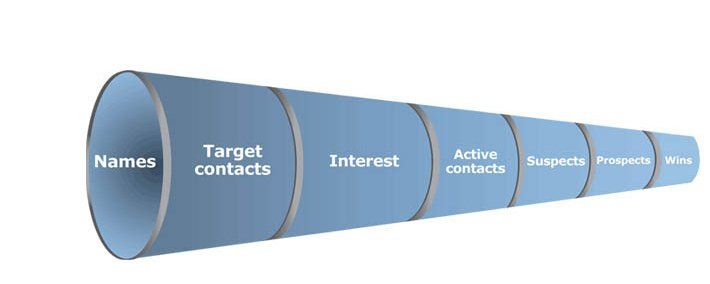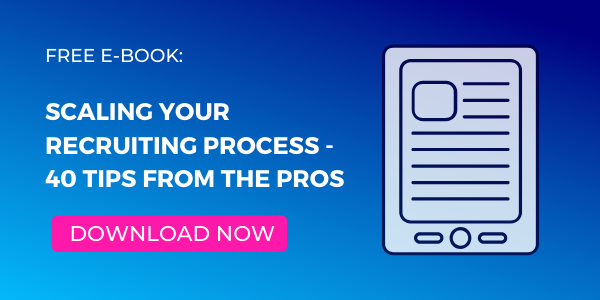It’s getting harder and harder to find great tech candidates these days.
Time to hire is increasing. Cost per hire is increasing. That persistent tech talent gap? Alive and well. Today, just about every company is competing for the same limited pool of highly-skilled technical talent, making it increasingly difficult to convince the best candidates to choose your organization. As a result, recruiters are placing more emphasis on sourcing passive candidates than ever before, breathing new life into the concept of talent pipelining.
Unfortunately, many organizations are approaching talent pipelining all wrong.
That may be a bold claim, but we help thousands of startups and tech companies across the country recruit talent on a daily basis, and we’ve seen the very best and very worst of talent pipelining firsthand.
With that in mind, we felt it was time to hit pause and go back to Talent Pipelining 101. Whether this article helps you refine your own talent pipeline or simply serves as a refresher for what you learned long ago, it never hurts to brush up on the fundamentals so let’s dive in.
See how your employer brand is performing in AI tools like ChatGPT and Google.
Table of Contents
- What is a Talent Pipeline
- The Talent Pipeline Framework
- Analyze Your Talent Pipeline Metrics
- Reevaluate Your Talent Pipeline Strategy
What Is A Talent Pipeline?

Simply put, a talent pipeline is a pool of qualified candidates able to assume recently vacated or newly created positions.
While this is a commonly accepted definition, there are several issues here. While it would be wonderful if every recruiter had a pool of qualified candidates they could call on to fill a position at a moment’s notice, this is an unrealistic expectation.
No matter how good your pipeline is, you’re dealing with passive candidates and your success rate will never be as high as it is with active job seekers. That “pool” word is also an issue. A talent pipeline isn’t a pool. It’s a process. Identifying potential candidates is certainly part of the talent pipelining process, but it’s literally just the tip of the iceberg.
We have to stop thinking of the talent pipeline as a thing (or pool) and start thinking of it as a behavior.
Instead, we define talent pipelining as a proactive, procedural approach to identifying, qualifying and nurturing passive candidates toward an eventual hire.
The talent pipeline can be traced back to the sales pipeline, a methodology that’s been utilized for decades. In a nutshell, a sales pipeline is a highly structured representation of the entire sales process — also known as the path to purchase.
Prospects (i.e., potential customers) are organized by the stage of the sales cycle in which they currently fall, helping salespeople understand where prospects lie on the path to purchase and what must be done to bring each individual closer to a conversion (i.e., sale). Let’s take a look at an example:

Courtesy Adara Associates
Few, if any, prospects will be ready to convert immediately, so the sales rep or marketing team will nurture them through the pipeline and only those that progress to the end will be considered high-value prospects. It’s this procedural nurturing that makes the sales pipeline so effective, and it’s also the main component missing from most talent pipelines.
So how do you do it? We’re glad you asked.

THE TALENT PIPELINE FRAMEWORK
Before we break things down, here's an overview of our six steps:
- Step 1: Identify Prospective Candidates
- Step 2: Make Initial Contact
- Step 3: Pre-Screen Your Prospective Candidates
- Step 4: Nurture Your Prospects
- Step 5: Set The Interview
- Step 6: Make A Job Offer
Like most complex projects, it helps to break talent pipelining into manageable tasks. This six-step talent pipeline framework will walk you through the entire journey, from finding the right prospects to getting them to sign on the dotted line.
Step 1: Identify Prospective Candidates

We weren’t kidding when we said identifying candidates for your pipeline was just the tip of the iceberg. You’ll need a sizable pool (there’s that word we hate) of prospective candidates to complete the remainder of the pipelining process, making this step absolutely critical to the success of your efforts.
At this stage, there’s no right or wrong way to identify potential candidates, but a little creativity goes a long way. We won’t walk you through every avenue to source these potential applicants in this article — that’s what our list of 80+ talent pipelining tools and resources is for — but we will encourage you to constantly explore new and innovative ideas. At this stage of the game, your options are virtually unlimited, so take advantage of every opportunity that presents itself.
How many prospects you will need to run an effective talent pipeline depends on your unique situation, but the answer should lie in your data. Let’s say that 20% of the passive candidates to whom you extend offers end up saying yes, and you have five open positions you hope to fill via pipelining. In this situation, you’ll need roughly 25 qualified prospective candidates. This back-of-the-napkin math is used to demonstrate that, with a little digging, you can almost certainly determine how large of a pipeline you need to meet your hiring goals.
Step 2: Make Initial Contact

This is where the procedural aspect of talent pipelining really begins. With modern sourcing tools and a little hard work, a recruiter can find thousands of candidates that may be a good fit without ever actually speaking with them, but that’s not a pipeline. It’s a rolodex.
Until you make contact with these prospective candidates and establish a relationship, you might as well not exist. We won’t lie and tell you this will be easy (you’ll get a lot of no’s), but that’s ok — persistence is key when talent pipelining. Keep a few things in mind when attempting to make initial contact to increase your odds of success:
- You aren’t asking them to apply. From the candidate’s perspective, asking them to apply in your first email is like asking someone to marry you on the first date: overbearing and desperate. Thankfully you aren’t asking prospective candidates to apply at this point. You’re just asking them if they’d be open to a conversation. Make sure the passive candidates you’re reaching out to understand you aren’t trying to recruit them today. You just want to get to know them and tell them a little about the company.
- You’re working on their terms. Assuming you’ve identified good prospects, they’re almost certainly gainfully employed. Given this reality, and the fact that you aren’t ready to offer anything concrete at this point, you can’t expect them to jump through hoops to meet with you. When someone agrees to talk, be willing to hop on a call or video chat. If they agree to a face-to-face, be open to meeting them before or after business hours, or even over the weekend. You’re asking the candidate to do you a favor, so it’s up to you to accommodate their needs.
Step 3: Pre-Screen Your Prospective Candidates

Most recruiters will find pre-screening to be a relatively simple task, as it’s very similar to the standard screening process every candidate is put through. The main difference is one of timing. Rather than waiting for a candidate to apply before vetting their skills and experience, pre-screening ensures only qualified candidates are passed through to the next stage of your talent pipeline.
Seasoned recruiters will be able to accomplish much of this by reviewing the prospect’s resume or LinkedIn profile, but there will inevitably be questions a piece of paper or digital footprint are unable to answer. Fortunately, talent pipelining makes uncovering this extra information relatively simple.
It can help to think of this step as two unique sub-tasks:
- Gaining internal alignment. Before you can identify prospective candidates for your pipeline, you’ll need a firm understanding of what it is you’re looking for. Start by speaking with senior leadership about future talent needs and potential skills gaps. This will take some of their time, but explain what you’re doing and they’ll recognize the value of the project. Next, speak with hiring managers in the areas of need you’ve identified (or areas you know the firm is frequently hiring for) to understand the skills and experience candidates must possess.
- The initial meeting. Your initial meeting with a prospect is the second segment of the pre-screening process. It allows you to start digging into their skills and experience for more insight, but remember that a soft touch is required. If your line of questioning is too forward, the prospect will likely feel as if they’re being interviewed for a position they haven’t even applied for. You can always uncover more insight during the nurturing phase (more on that in the next section), so don’t overextend here.
You’ll screen out plenty of candidates through this process, and while this can be frustrating, it’s the entire point of pipelining. Taking the time to remove unqualified prospects early on will pay off down the line, so don’t relax your standards for the sake of numbers.
Step 4: Nurture Your Prospects

The nurturing phase is the holding tank of your talent pipeline. Candidates have been identified, relationships have been established and skills have been vetted. Now you have to keep them interested until the right position presents itself.
Candidate nurturing will allow you to accomplish two primary objectives:
- You’ll maintain top-of-mind awareness with the prospects in your funnel, which means when they are ready to make a move, your opportunities will be the first thing they think of.
- You’ll be able to learn even more about your prospects and their potential fit with your organization.
Candidate nurturing is really no different than staying in touch with a friend you don’t get to see every day. Emails, phone calls and the occasional face-to-face conversation over coffee are all it takes to nurture your relationship with a candidate. You’ll want to touch base on a regular basis, but don’t overdo it. Use the insight you’ve gained from your relationship with the prospect to set your cadence. If they’re always eager to speak with you, consider reaching out once a month. If your conversations frequently feel rushed, however, dial it back to once a quarter.
Aside from maintaining the relationship, nurturing your prospects will allow you to continue learning more about their potential fit with your company, so make sure to ask plenty of questions. What is your current position? What are your core skills and competencies? How long have you been in the industry? The sky is really the limit here, though we recommend avoiding any sensitive subject matter (salary, benefits, etc.) until later in the process. Again, it’s important not to be too forward with these questions, so be subtle with how you weave them in. Intersperse them around discussions of current events, common interests and so forth to keep the conversation flowing in a natural manner.
Remember to be strategic when overtly discussing your company and the opportunities it has to offer. Use examples of the unique projects your team is working on, or discuss your training and career development opportunities. Frame the conversation to pique the interest of the prospect.
Finally, take detailed notes after every conversation. This is competitive intelligence, and it will be invaluable throughout the pipelining process.
Step 5: Set The Interview

Let’s consider some of the information you’ve likely uncovered about the prospects in your talent pipeline after the initial meeting and nurturing phase:
- You understand their capabilities and experience and can present them to the hiring manager before reaching out.
- You know what they like about their current job, and what they could do without.
- You have a feel for their personality and work style and are better equipped to assess cultural fit.
Not too shabby, but you aren’t done yet. After all, you didn’t collect this information just to kill time.
Unlike traditional “take what you get” recruiting, talent pipelining allows you to leverage the relationships you’ve established and the information you’ve collected to actively pursue the candidates you believe would be best for your organization. Now is the time to use that information to make strategic decisions about who to reach out to for an interview. Let’s consider a few examples:
- Prospect A looks like a perfect fit on paper. They check off all the experience and expertise boxes, and they seem to be an ideal cultural fit. But as a result of your conversations with them, you know they’re happy with their current position and aren’t thinking about making a change. Pass.
- Prospect B, on the other hand, doesn’t meet all of your prerequisites. Maybe they have less experience than you’re looking for or they aren’t proficient with a certain piece of software. If this were a traditional hiring process, you’d likely have passed on them after reviewing their resume. But by nurturing your relationship with this individual during the pipelining process you discover that they actually exceed everything the hiring manager is looking for and they’re eager to assume a bigger role that will allow them to grow. Time to request an interview.
Not every situation will be so cut and dry, but this example highlights how talent pipelining can significantly increase the odds of passive candidates agreeing to an interview — not to mention being the best fit for the position — if you effectively utilize the information you’ve collected.
Step 6: Make A Job Offer

We’ve reached the grand finale of the pipelining process: the final offer. Once again, the information you’ve collected by nurturing a relationship with the candidate throughout the talent pipeline process can and should inform this stage of the recruiting cycle.
What are their salary expectations? Are there any potential logistical hurdles (relocation, upcoming maternity/paternity leave, etc.) to account for? Should the job description be tweaked to reflect the individual’s unique experience and potential? Everything you know about the candidate can increase the odds of them accepting your offer, so make sure to use it.
At this point, one of two things will happen: Either the candidate will say yes, and all will be right with the world, or they’ll reject your offer. Either way, your work isn’t over yet. Candidates who accept your offer will enter your standard onboarding process (a topic for another day), and candidates who say no will be recycled back into your talent pipeline.
Candidate recycling is simply the act of returning candidates who reject your offer to the nurturing phase of the talent pipeline framework, assuming everyone remains on good terms following the interview and negotiation process. Just because a candidate decided not to move forward right now doesn’t mean they won’t be right for a future position. Maintain a positive relationship with these individuals and you may be able to approach them again in the future.
Analyze Your Talent Pipeline Metrics

While not technically part of our six-step framework, performance analysis should be a top priority for anyone undertaking a talent pipeline initiative. This approach requires a lot of work, and while the payoff can be massive, you must be sure your strategy is producing the returns you require. There are several metrics that can be indicative of talent pipeline performance:
- Time to Hire - Reducing your time to hire may be the greatest benefit of an effective talent pipeline. Your pre-established relationships with individuals in your pipeline should allow you to reach out when opportunities open, and assuming you’ve identified prospects who possess the right skillset and can be swayed by your offer, you can significantly reduce this metric.
- Offer Acceptance Rate - You’ll also want to pay close attention to your offer acceptance rate. Odds are very good this will be slightly worse than that of your standard recruiting process, but that’s ok. You’re dealing with passive candidates here, and this group will always be more likely than active candidates to say no. If this ratio starts to get too high, however, you should reconsider the criteria by which you’re judging the prospects in your pipeline.
- Retention - Retention is another useful metric to judge the impact of your talent pipelining efforts. Given everything you’re able to learn about candidates during the process, recruiters should be able to target individuals they feel will be an excellent long-term addition to the organization. Even if your pipeline produces fewer overall hires, retaining those individuals for an extended period of time makes the effort worthwhile.
Reevaluate Your Talent Pipeline Strategy

A talent pipeline can be your secret weapon, but finding the right prospects and nurturing them through the process takes strategic thought and a lot of hard work. When you consider how a talent pipeline can produce higher-quality candidates and improve hiring results, however, the effort seems well worth it. Our process may not work for every organization, so don’t be afraid to experiment. What matters most is that you develop a structured and measurable process that addresses the unique needs of your organization. And above all else, remember one thing: It’s a process, not a pool!




